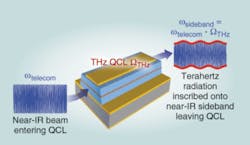A promising new method to piggyback terahertz radiation (in the form of sidebands) onto light at telecommunications wavelengths has been demonstrated by a collaboration between The University of Paris, Ecole Normale Supérieure (Paris, France), Thales Research and Technology (Palaiseau, France), TeraView (Cambridge, England), and the Cavendish Laboratory (Cambridge, England).1 It is an impressive proof-of-principle that will in the shorter term have impact for terahertz researchers, and in the longer term may provide a new way to up the bandwidth of telecommunications.
At the heart of the system is a terahertz quantum-cascade laser (QCL); simply put, a near-IR beam is passed through the QCL cavity. Through a cleverly phase-matched interaction in the cavity, a near-IR beam emerges with two sidebands of plus and minus the terahertz frequency.
The study follows work done by researchers at the University of California, Santa Barbara, who showed a similar effect in gallium arsenide (GaAs) quantum wells irradiated with terahertz radiation.2 But while the previous study used up to 20 kW of terahertz power from a free-electron laser, the field strengths inside terahertz quantum-cascade lasers make for a similar nonlinear process on a decidedly more compact scale.
The researchers started with two 3-mm-long designs, one with so-called “single-metal” architecture on an insulating substrate and one with “double-metal” architecture on a doped substrate. The single-metal waveguides were wet-etched for a ridge width of 170 µm, whereas the double-metal versions were made via wafer bonding and then reactive-ion etching.
Mixing in GaAs
The trick in both designs was to incorporate a lightly doped 1-mm-thick layer of GaAs midway through the 90 injector/active layers of the QCLs. This effectively provides a waveguide for the near-IR light provided by telecom lasers at either 1.3 or 1.55 µm and injected into the QCLs via a high-numerical-aperture objective. The bulk nonlinear susceptibility of the GaAs layer allows for a mixing of the TE-polarized near-IR and the TM-polarized terahertz, resulting in the sidebands on the near-IR output.
A match of the modal and bulk refractive indices in the single-metal waveguides allowed phase matching at 1.3 µm, while tuning of the phase-matched frequency was accomplished in the double-metal architecture by etching the ridges to different sizes between 42 and 52 µm. In this way, the process could be effectively phase-matched throughout the telecom spectral region.
One of the study’s coauthors, Carlo Sirtori, unveiled the very first QCL at Bell Labs in 1994 and has since then helped QCLs stay in the limelight. “I’m not sure how much terahertz can help telecom,” Sirtori says of the new method. “I prefer to think that telecom can enormously help terahertz.” Because the near-IR output can be fiber-coupled to standard telecom equipment, analyzing the terahertz radiation is as simple as plugging the fiber into a spectrum analyzer. Beyond providing a sigh of relief for terahertz researchers who want to know exactly what they’ve got, the method provides a way to transmit terahertz over kilometer distances-an otherwise impossible task.
Once delivered, the terahertz sidebands can be used to seed an oscillator on the other side, an idea Sirtori hints that his group has already accomplished. But then what? Sirtori believes one application for such fiber-delivered terahertz could be in security applications, in which a single central source is distributed among many in-phase oscillators; for example, airport scanners.
The extremely short nature of the upper-state lifetime in QCLs means that they can be modulated at high frequencies; that modulation, resulting in sidebands on the sidebands, can in principle be done at frequencies more than ten times higher than the highest frequencies used to modulate telecom lasers, so the approach could be adapted to significantly up the bandwidth for information transfer, all the while incorporating existing telecom infrastructure. “It’s a promising way to send terahertz information over the commercial network, which is very pervasive,” says Federico Capasso, who headed up Sirtori’s group at Bell Labs and is now at Harvard University. “This is very exciting.”
Terahertz veteran Erik Bründermann from the Ruhr-Universität Bochum (Bochum, Germany) is also impressed. “There is no doubt that the group has done an excellent engineering job in designing and fabricating a tailored device to demonstrate the terahertz-sideband imprinting on near-IR carriers,” he says.
However, both Bründermann and Capasso note that a necessary step is to raise the temperature of the process, demonstrated at 10 K. Terahertz QCLs have been demonstrated at temperatures as high as 164 K,3 but Capasso says that commercial success for the technique will await higher temperatures, namely at a level amenable to Peltier cooling around 200 K.
REFERENCES
1. S. Dhillon et. al., Nature Photonics, doi: 10.1038/nphoton.2007.94 (2007).
2. S.G. Carter et. al., Appl. Phys. Lett.84, 840 (2004).
3. B.S. Williams et. al., Optics Express13, 3331 (2005).
D. Jason Palmer | Freelance writer
D. Jason Palmer is a freelance writer based in Florence, Italy.
